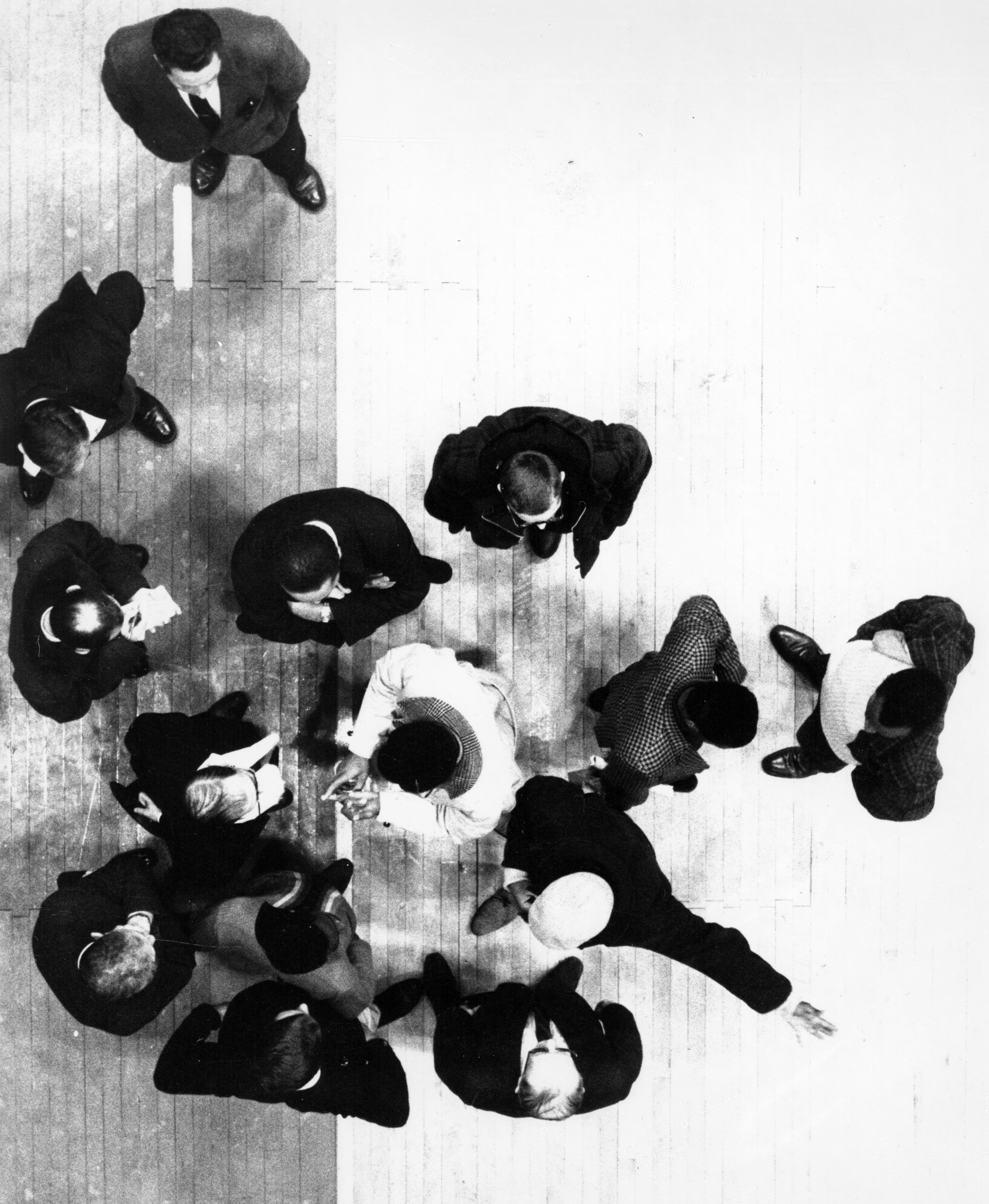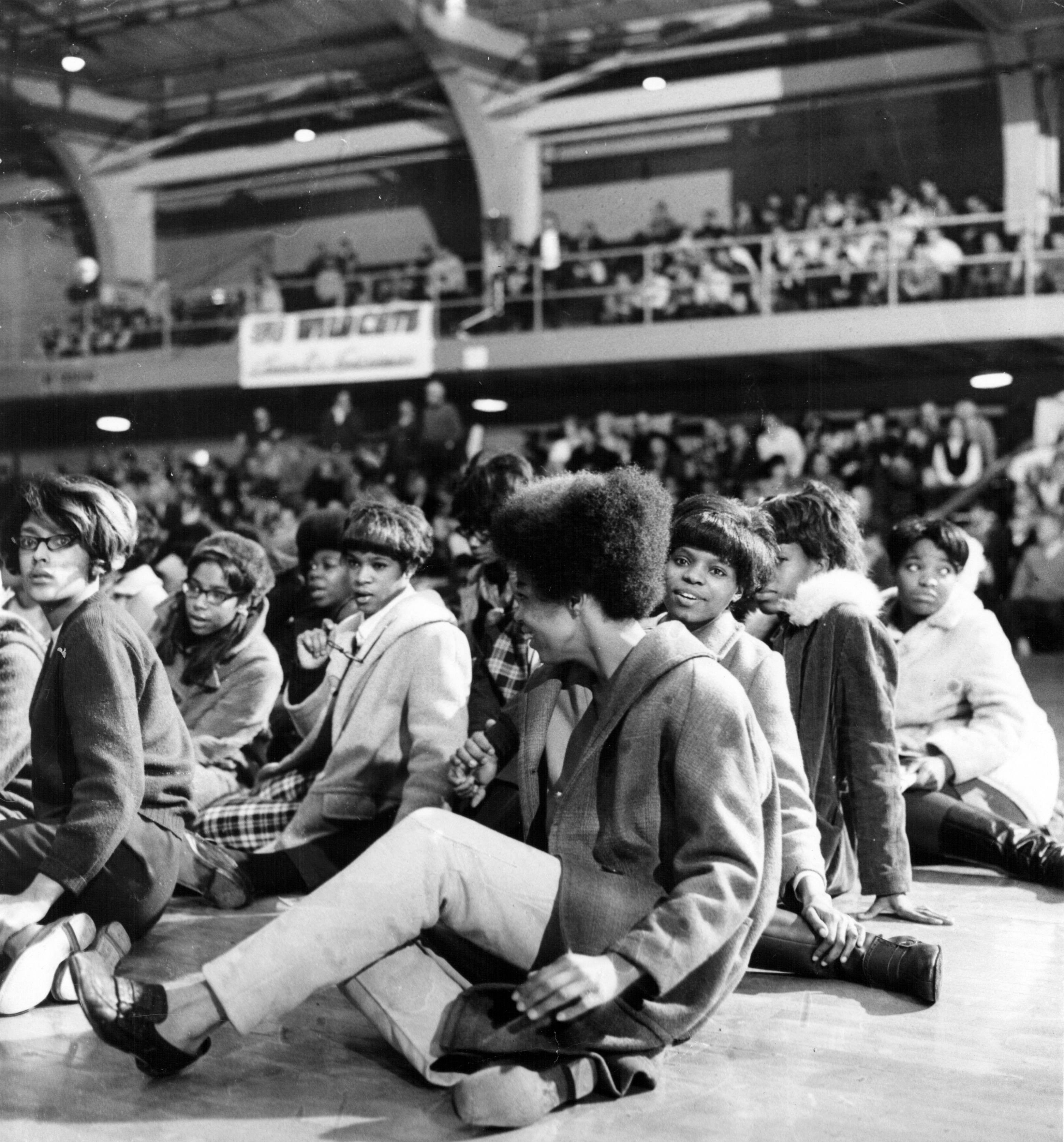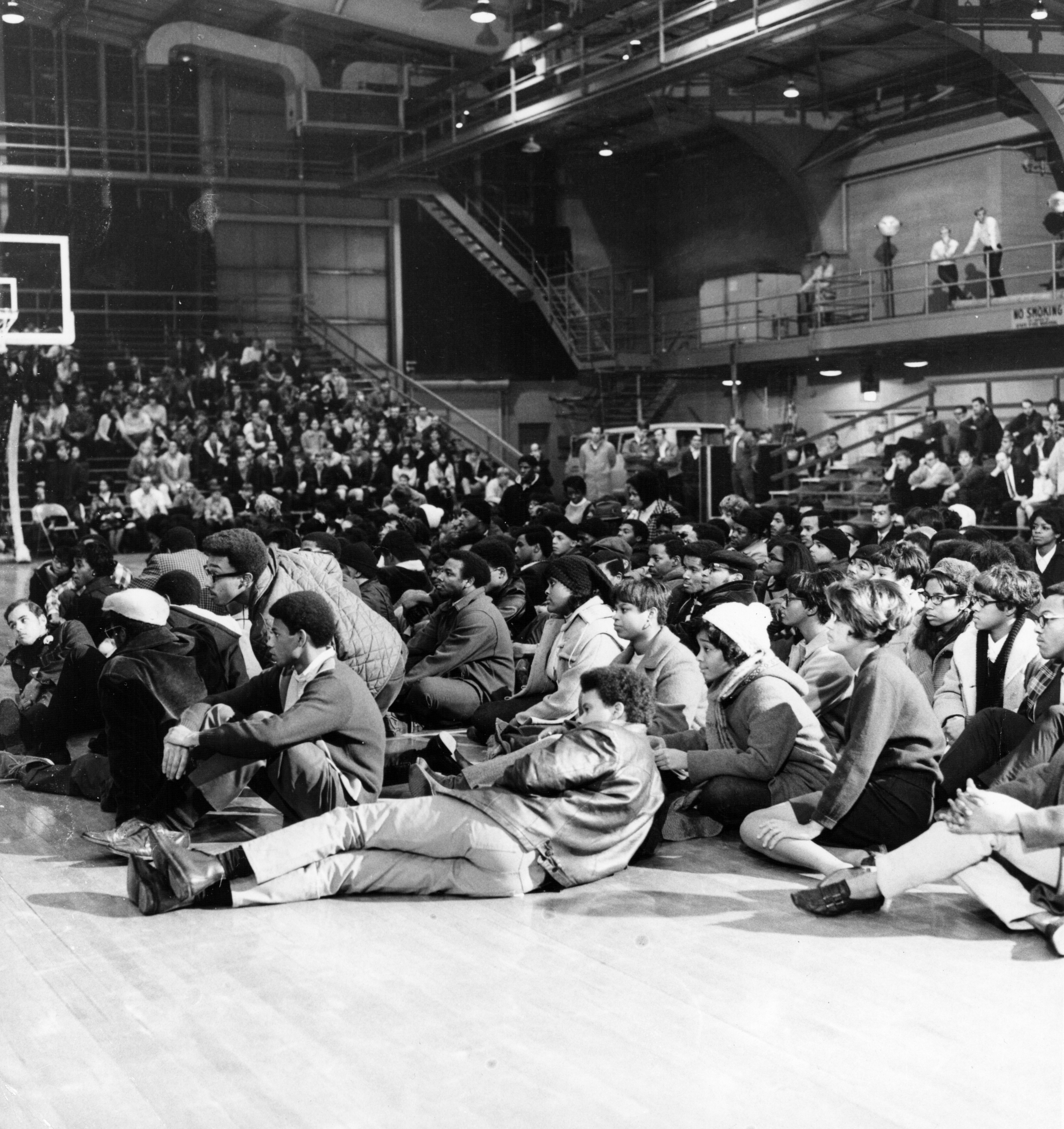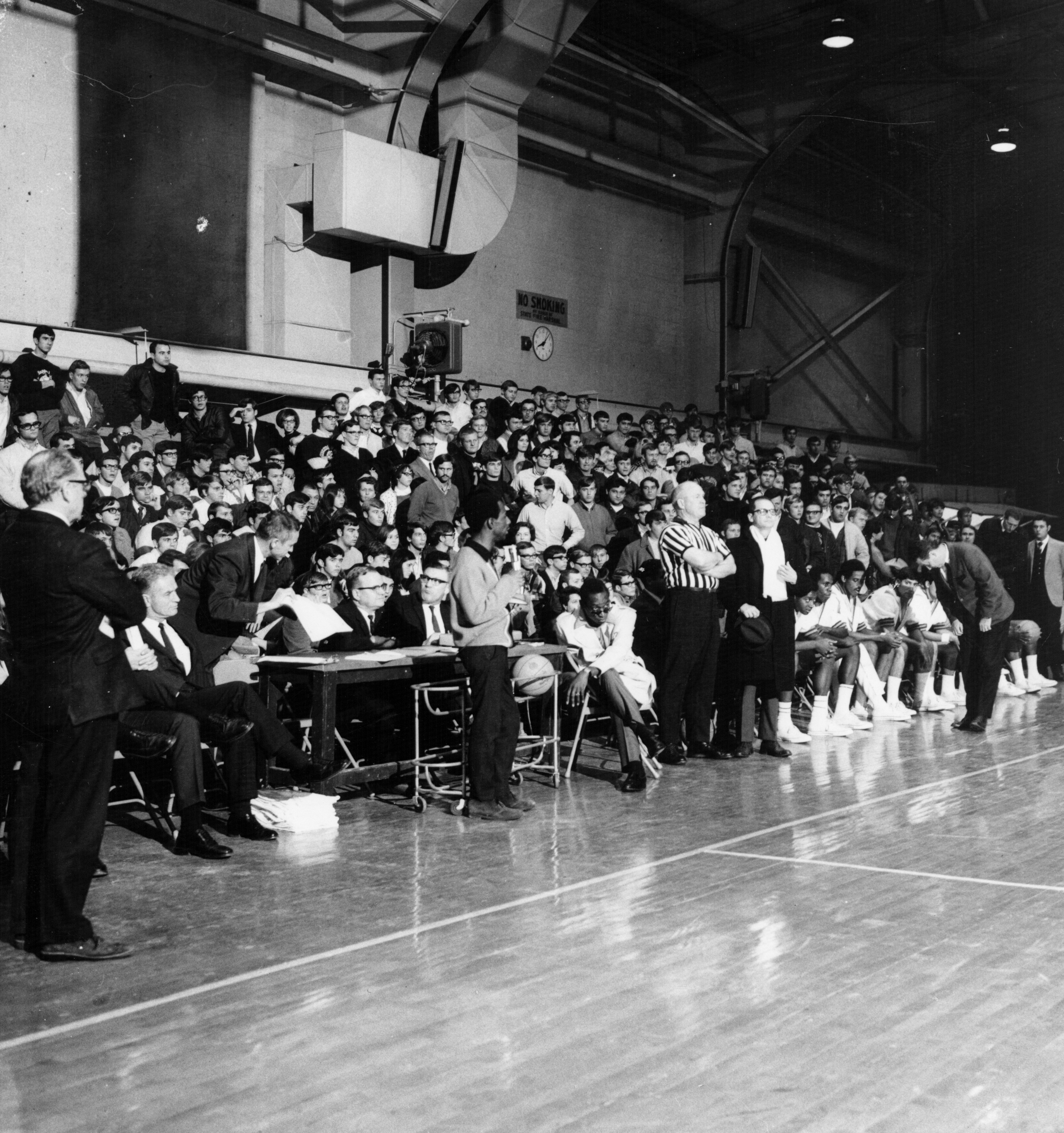Sit-in at the Pan-American Basketball Game
December 1968
During the 1968-1969 school year, long simmering racial problems at Northern finally exploded in the form of a sit-in at a basketball game on December 10, 1968.
The final catalyst for the sit-in, which was the "first instance of organized racial protest in the Upper Peninsula" according to the Mining Journal, occurred the previous night. Three African American students walked into Spooner Hall. The NMU security policeman refused to believe that they were students even after an RA vouched for them and called for more police. These officers arrived with billy clubs, but there was no physical altercation. The director of the security police replied that since some Job Corps girls had moved into Spooner Hall there were required checks made when unidentified personnel were in the vicinity.'One of our officers simply asked for the student identification of some (Negro) persons he did not recognize as being students,' Stambaugh said. 'The persons questioned became very abusive and the officer had to ask for help.’"
The next day, Black Student Union leaders met with Jamrich and other administration and faculty members to discuss a report released by the Human Relations Council "which charged that the university atmosphere ‘deprives the Negro’" and the wording of a questionnaire released by one department about the Job Corps which some students perceived as racist. (The wording of this questionnaire is unknown.) The Spooner Hall event of the previous night went undiscussed.
That night, an important basketball game against the Pan-American team was supposed to take place. Before the game could begin, 125 to 150 African American students walked out onto the court and sat down. The Mining Journal reported that some of the students may have been attendees of the Job Corps or men from the K. I. Sawyer Air Force Base. Jamrich attempted to convince the students to stop the protest in return for a meeting with him the next morning or after the game. The students refused, forcing the cancellation of the game. Fans gathered in the stands booed and yelled when told to leave but ultimately, "cooler heads prevailed." Jamrich allowed the BSU to remain in the Fieldhouse. They stayed there until 9:45 and then left.
The group’s leaders were David Williams and Melvin Payne, and each listed different reasons for the protest. David Williams presented a list of “complaints and demands” to the Mining Journal:
- More recruiting of black faculty and administrative personnel.
- Establishment of a program to recruit black students from the ghettos to come to NMU, which program ‘should be headed by Vernon Black of New Rochelle, NY, a graduating senior, and assisted by me (Williams).
- More black culture classes (via art, music, etc.)
- More recruitments of black athletes and hiring of black coaches.
- A re-evaluation of and investigation of the NMU police department.
- Removal of two NMU security police.
- Establishment of an Upward Bound program (to enable high school students to come to NMU for the summer and encourage their going to college here).
- More black students in key campus positions and university jobs.
- Hiring of a black dean.
- NMU must stop ‘its prejudice of the Job Corps girls’ and ‘better treatment for our black brothers from Sawyer Base.’
- Better treatment from the community for off-campus housing for blacks.
- A black person on every (NMU) committee.
Melvin Payne, on the other hand, said that David Williams’ opinions were his own. He gave his own list to Jamrich of reasons for the protest. It asked for:
- Investigation of the NMU security force.
- Two resident assistants in each hall
- Negro history changed to Afro American History
- A course in literature
- Recruitment of black faculty.
Although the Mining Journal reported that the students stated that they planned on using only non-violent methods, their headline proclaimed, “Black Militants Stage Protest on Fieldhouse Floor.” It might be assumed that they justified calling the entirety of the protesters “militants” because one individual, Joseph Davis, used the opportunity to talk about how, “’in America we must use force to maintain our aims’" and because the protesters gave the black power salute during the national anthem before walking out onto the gym floor. The Editor of the Mining Journal argued that while African American students at Northern were undoubtedly mistreated, the display was still “regrettable” because it was unorganized--there was no single clear leader or single list of demands. He stated that the students’ insistence on “an immediate redress of their alleged grievances…certainly was beyond the realm of logic and decency."
He noted that some of their demands, which they wanted to be fulfilled immediately, were simply impossible and that the current state of affairs was not the administration’s fault. They had hired African American faculty and administration members in the past, but those faculty members had left. They had not had much luck attracting any African American professors to Northern given the racist climate of Marquette. Jamrich also stated that he felt that the demands were unwarranted: the administration was already in the process of creating more financial aid for black students, that as many on-campus jobs as possible were already being given to black students, that he had asked the BSU for a list of three hundred books on black culture that they would like in the library and that it was not provided until six weeks later and it was unorganized, that there were already many black athletes at Northern and that black coaches would be considered if any ever applied, that black students were already a larger proportion on student committees than their relative population on-campus. He seconded the idea that the lack of black faculty was due to a lack of black faculty wishing to teach at Northern, and noted that Northern had hired minority professors in the past and would continue to do so.
Jamrich and the protesters met the following day. Jamrich told the students that disrupting an official university function merited discipline. However, the students were never punished for the sit-in. The meeting led to several agreements:
- The development of a human rights commission to deal with complaints of discrimination and injustice through processes other than protests or confrontations
- The “development of a different system and procedure of identification card checking by the NMU security division, with every effort being made to improve the relationships between the security staff and black students.”
- A review of the recent incidents between security officers and black students
- In response to complaints that the security police always searched cars for liquor and narcotics if the driver and passengers were black, the NMU security police agreed to not search cars without the permission of the driver and only “’within the framework of the legal provisions for this activity.’”
- The employment of more black students by the university in better jobs, including security police positions.
- The recruitment of more black faculty members and students, along with a black history course and more black literature in the library
The Black Student Union maintained that their action had been a last resort and had not been hasty. They explained “the position of the Black community to the rest of the University” at a series of meetings in the dorms. Ultimately, the students were not disciplined and the matter seems to have basically dropped out of student and community consciousness.
Click here to listen to an interview with David Williams with our own University Archivist, Marcus Robyns. (September 9, 2015)





